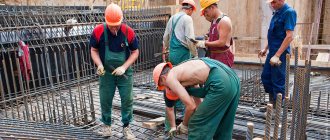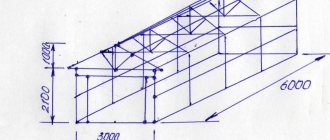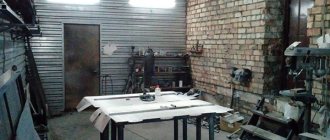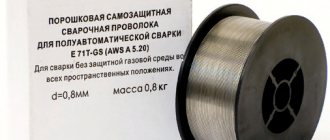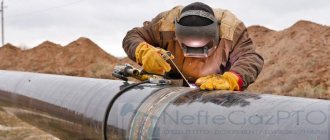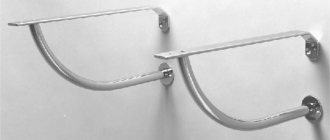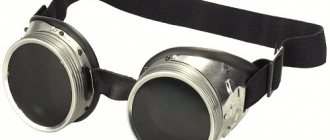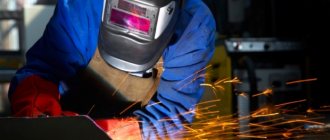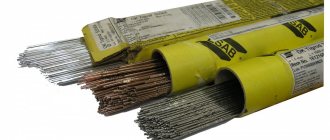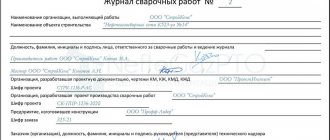Welding is considered a dangerous and harmful type of work. At production sites, traumatic situations arise constantly.
The organization of the welding process refers to a whole range of procedures.
This is due to the presence of flammable substances and heated objects. Therefore, when carrying out welding work, it is necessary to observe safety precautions.
The need to follow the rules
Regardless of the type of equipment used, the welder and other people present at the work site are affected by negative factors.
The need to comply with the rules is explained by the possibility of the following traumatic situations:
- sparks getting on the welder’s clothes;
- burning shoes made of fusible materials;
- injury to the skin of the face and organs of vision by hot metal vapors;
- ignition of materials located on the site due to the spread of sparks;
- burns from particles falling on the skin;
- high-intensity electric shock;
- falling of poorly fixed parts of metal structures.
What is the danger?
The physical and chemical hazards of welding include:
- high noise level emitted by welding machines;
- intense infrared and ultraviolet radiation;
- blinding visible light;
- content of heavy metals in melt vapor;
- presence of hot particles above the weld pool;
- thermal energy generated during burner operation.
When carrying out welding work, a person is exposed to ultraviolet radiation.
General provisions when carrying out welding work
When connecting elements of metal structures in any way, observe the following rules:
- The equipment is installed in specialized workplaces equipped with protective screens. The height of the screen must be at least 180 cm.
- In a closed room, welding begins after starting the supply hood.
- In workshops with high humidity they work in a rubber protective suit. When the welder takes a sitting or lying position, felt pads are used.
- Before starting welding, check the integrity of the power and grounding cables.
- When repairing a car, the battery mass is first disconnected. The fuel tank is dismantled.
- The unit can only be moved when disconnected from the network. The holder is installed on a dielectric substrate.
Requirements for an employee to be allowed to work
A person starting welding must:
- Have the qualifications required by law.
- Provide evidence of completion of a brief training on TB.
- Have skills in working with welding units. The devices are used strictly for their intended purpose, with the permission of the master.
- Use personal protective equipment and maintain work clothes in proper condition.
- Be familiar with the procedure for providing first aid to people injured during production.
- Be able to use fire protection systems in emergency situations. It is necessary to familiarize yourself with the principle of operation of alarm sensors, the location of emergency exits, and the evacuation plan.
We recommend reading: Job Description Items for Electric and Gas Welder
The employee must have professional skills and knowledge.
Requirements for welding equipment
Since arc welding is used for most welding work, we will talk about the requirements for the welding equipment needed in this case.
To achieve high quality welded joints, the following requirements must be met:
- Precise assembly and fixation of welded joints in the working area. In this case, the features of the workpieces must be taken into account, such as significant permissible deviations from the nominal dimensions and shapes, possible burrs, scuffs, scale, adhered metal splashes and possible deformations during the welding process.
- Reliable protection of the weld pool from atmospheric influences using shielding gas, flux, the use of self-shielding wires, vacuum chambers, etc.
- Maintaining the required position of the heating source relative to the seam being formed with compensation for random deviations of the line from the calculated position.
- Maintaining specified parameters or changing them according to a given law. When fulfilling this requirement, unexpected deviations of connection parameters from the initially set values are taken into account.
- Use of the most modern welding technologies and materials, such as forced modes, multi-arc and multi-electrode welding, strip electrodes, etc.
High productivity of welding work can be achieved by meeting two requirements:
- Use of advanced welding processes.
- Mechanization, automation and robotization of welding production. You need to understand that automation and robotics of welding are an important condition for increasing the level of work performed. Its implementation allows you to consistently obtain high-quality welds.
Welding equipment is subject to high reliability requirements. Good results can be achieved using:
- Taking measures to create optimal conditions for a particular welding method. Such requirements may include high temperature in the welding and seam zone, a powerful non-stationary magnetic field, intense light radiation, splashing of molten metal, intense release of dust or aerosols.
- Increasing the service life of consumables that quickly require replacement. This effect can be achieved using modern means of condition monitoring, diagnostics and troubleshooting using quick-change parts, blocks and devices.
- The use of the most reliable elements, in other words, in order to meet safety requirements, preference must be given to technical solutions and serial devices that have already been proven in practice. Unification and aggregation play an equally important role.
High reliability is one of the key requirements for the operation of welding equipment. After all, in this way it is possible to achieve high quality welded joints and the productivity required by the company.
Mandatory requirements also include the rational use of materials for the production of the equipment itself, as well as the electrical energy and materials used in the welding process. These requirements are met through actions such as:
- competent construction of standard size ranges and selection of optimal configurations of welding equipment;
- increasing the efficiency of energy sources, reducing their size and weight - for example, inverter or transistor sources can be used during arc welding;
- reducing the proportion of spattered metal during the welding process by choosing the optimal method of work, for example, pulse-arc in a mixture of gases;
- selection of the most suitable composition and consumption of protective gases, flux composition and the principle of its supply to the work area and cleaning after completion of all processes.
High ergonomics of welding equipment can be achieved by:
- improving sanitary working conditions by sucking out aerosols and dust, cooling burners, and protecting specialists from light radiation;
- mechanization and automation of all work performed;
- ensuring compliance with occupational safety requirements when working with welding equipment, as well as taking into account the requirements of engineering psychology in the process of creating tools for managing and monitoring the operation of the equipment used;
- competent approach to the layout and form of equipment, organization of workplaces.
By complying with these requirements for welding equipment in production, it is possible to improve the quality of welded joints, productivity and reliability of the devices themselves.
A significant reduction in the cost of equipment and its maintenance costs is achieved through:
- reducing the consumption of materials for welding equipment and simplifying its manufacture;
- purchasing or creating equipment with exactly the set of functions that are necessary for a particular production, that is, one of the key requirements is avoiding redundancy, choosing in favor of mass-produced equipment;
- unification and aggregation of equipment used in welding.
Note that among the requirements of most of the techniques of the most common arc welding method, there is no need for complex equipment. Arc welding can be carried out using manual or simple mechanized tools. The role of the latter can be played by a semi-automatic welding machine.
Necessary skin and eye protection
When starting work, the welder must use the following accessories to prevent injury:
- Work suit. Special clothing is issued by the enterprise. It is sewn from fire-resistant fabrics - tarpaulin, suede, split leather. Suits made of synthetic fabrics are prohibited. In winter, they wear cloth clothes.
- Mittens or gloves. Suede products are of the highest quality. The tarpaulin burns quickly, so you will have to change the mittens often.
- Shoes made from different materials. Most often, enterprises provide employees with tarpaulin boots or boots with rubberized soles. Shoes should not have nails that increase the risk of electric shock.
- Welding mask. It is not advisable to use self-made shields. Even a small gap in the mask can cause damage to the organs of vision.
Increased demands are placed on industrial safety equipment for welding.
Requirements for employees and managers
Before starting work, you must entrust it to competent employees and their managers. In general, according to the FNP standards, in any welding production there should not be a shortage of personnel performing high-quality work.
If any workers are appointed, then they are obliged to follow the welding technology and not deviate from the technological map. Managers are required to establish the authority of employees and check the quality of their work. All production employees must observe safety precautions, comply with labor protection and environmental protection rules. These are general provisions.
Now let's talk more about the leaders. Managers are required to fully train personnel to perform diverse tasks and certify their employees. Training and certification are carried out based on the welder’s job responsibilities, skills and category. Managers and welders can be people who have undergone appropriate training and have an education document. The work assigned to welders must correspond to their qualifications.
Managers themselves must have all the necessary knowledge and skills to delegate work and monitor the process. Specialists must be able to competently draw up technical documentation, control the quality of welding work and monitor the progress of welders’ duties.
As for welders, qualifications are assigned to them based on the resolution of the Ministry of Labor. All masters must have a certificate indicating their rank. To verify the authenticity, the ID must have a personal QR code and a number by which the document can be found in the unified register.
Only those who comply with the rules stated above are allowed to manage and perform welding work in hazardous production. Next, we will talk in more detail about the requirements for the welding work itself, and find out what the craftsmen should be provided with at their workplaces.
Occupational Safety and Health Regulations
By properly starting and maintaining the welding process, most problems can be avoided.
Preparation for work
The work shift begins with an assessment of the condition of the equipment, during which the following actions are performed:
- check the main units of the device, consumables and accessories;
- when working at height, securely secure scaffolding and other structures;
- the unit is grounded, which eliminates the possibility of electrical injuries;
- dry the power cables if there are drops of moisture on them (water contributes to the destruction of the insulation);
- measure the length of the wire (you cannot use products longer than 10 m).
Before work, check the main units of the device and consumables.
At the end of the process
When completing welding, you must also comply with labor safety requirements.
Workers perform the following actions:
- Disconnect the unit from the electrical network.
- Before checking the quality of the welded joint, wait until the parts cool down. It is prohibited to touch hot metal.
- Clean the equipment from contaminants and check the integrity of the main units. Place auxiliary tools in specially designated containers.
During emergencies
In such cases, special requirements for labor protection are imposed.
We recommend reading: Welding technology for internal combustion engine blocks
These include the following rules:
- when the pipeline is under pressure, welding work is stopped;
- welding is prohibited in the presence of explosive vapors in the room;
- it is necessary to think over an action plan to help prevent injury to employees in accidents.
What SNiP says about welding metal structures
SNiP imposes special requirements for welding work on metal structures. Compliance with them is a guarantee of obtaining a weld of proper quality. The main requirement is strength and reliability.
Welded connections of metal structures in accordance with SNiP 3.03.01-87 must be carried out in accordance with the instructions:
- In cases where there are no certificates for materials or when the warranty period for their storage has expired, it is necessary to determine the mechanical properties of butt joints. Prototypes are being tested. They are tested for static tension and bending.
- Auxiliary materials are stored in factory containers, sorted by batches, brands, and diameters. The storage area must be dry and heated.
- Coated electrodes, fluxes and cored wires must be calcined before use. In this case, it is necessary to comply with the modes specified in the technical documentation for them. Calcined materials are stored in warehouses with appropriate temperature and humidity, or in drying cabinets.
- At a certain distance from the place where the weld is located, the welder must affix his personal mark. If the work is performed by several performers, then their prints must also be available. Another identification is acceptable - drawing up diagrams on which welders put their signatures.
Requirements for welded structures made of steel:
- Welding can begin after the assembly has been checked according to the drawings for it. Tolerances must be taken into account when performing the inspection.
- Tolerances when welding metal structures must correspond to the values specified in the relevant regulatory documents.
- It is necessary to clean the edges of the weld from dirt, paint stains, grease, and rust.
- The welding mode must be stable. Deviations of ± 5% are allowed.
- The amount of calcined materials in the workplace is limited. It should not be higher than the need for them in the amount of half a working day. In the case where steel structures have high fluidity, the electrodes removed from the drying oven or immediately after the completion of the calcination process should be used within the next couple of hours.
- When welding in low temperature conditions, local heating of the action area should be carried out.
- The places where installation devices are welded to the structure are preheated.
- If sheet elements with a thickness exceeding 20 mm are welded, then in the case of arc welding, options are used that provide a reduction in the welding speed by the cooling method. These include sectional cascades - reverse-stage, as well as those with a double layer.
- When making arc welding connections made by full penetration, the root of the weld should be cleaned before starting the process.
- When there is a break in arc welding, it can be resumed after the crater and end section have been cleaned of slag.
- If the drawings provide for a concave profile, then this can be ensured by selecting the appropriate welding modes. Sanding with abrasive can also be used.
- In automated welding, the beginning and end of the welded joints must be placed outside the elements onto strips. At the end of the welding process, the strips must be removed using oxygen cutting. The use of planks is provided for in the drawings. When using arc welding, it is prohibited to extend the crater beyond the weld.
- When multilayer welding, the bead can be started after stripping the previous one. It is mandatory to remove areas with cracks.
- After welding is completed, the assembly bolts and mounting hardware should be removed.
- The quality of parts intended for fastening and tacks should not be worse than the base metal being welded.
In addition to SNiP, when welding metal steel products, it is necessary to take into account the requirements of such a regulatory document as SP welding of metal structures.
SNiP requirements for welded joints representing reinforced concrete structures:
- The dimensions of the rods, as well as the magnitude of their maximum deviations, must comply with the requirements of GOST 14098.
- If welding is performed mechanized, then direct current up to 500 A should be used.
- When performing the process using arc welding, it is advisable to use transformers.
- Before starting the welding process, the reinforcing bars should be cleaned in an interval that exceeds the weld by 10-15 mm.
- When welding reinforcement bars, if the gap value specified in the technical documentation is exceeded, it is permissible to use inserts made of material of the same class and diameter as the bars.
- The length of rods made of concrete must be at least 150 mm. When using inserts, the permissible length of the rods is at least 100 mm.
- The welded parts of the reinforced concrete structure must be rigidly fixed. Holding them with a crane is prohibited.
- After the welding process is completed, traces of metal splashes and slag should be cleaned.
- At sub-zero temperatures, the use of tack welds in cross-shaped connections of reinforcing bars is not permitted.
- Burn marks from arc welding are not allowed on the surface of reinforcing bars.
- When manual welding in the case of sub-zero temperatures, the current value should be increased, as well as preheating.
Welded joints are made depending on their spatial position and further operating conditions.
What should the room where the work is performed look like?
Welding is carried out in a specially equipped workshop with good ventilation. When working in closed containers, additional means of protection against harmful vapors are used. The room must have a compartment for storing gas cylinders.
Each workplace is fenced off with a screen.
The welding room must have good ventilation.
Special requirements are placed on the level of illumination and the absence of explosive materials in the welding zone.
Standards for storing tools and operating equipment
When storing and using technical equipment, observe the following safety rules:
- The equipment is stored in a dry, heated room, free from insects and rodents. Damp hoses and cables cause accidents.
- Electrodes are stored in a cool, dry place. When storing in conditions of high humidity, the rods cannot be used to initiate an electric arc.
- Generators are placed so that they do not fall or be subject to shock. Devices without a water seal cannot be used for welding. It is not recommended to use generators at temperatures below zero.
- It is forbidden to install hoses longer than 20 m. When working at heights, the length of the elements can be increased to 40 m. It is forbidden to swap oxygen and acetylene supply hoses. After completing the work, they are folded into rings, without bending or squeezing.
- Before removing the cap from the cylinder, check the integrity of the fitting and valve. Do not knock out the part with a hammer or direct the flow of gas towards yourself or other people. The cylinder is placed on a flat stand in a vertical position. Do not place it near heat sources.
Control and registration of documents
The requirements for welding work at hazardous production facilities do not end with the selection of personnel and management, as well as compliance with welding technology. Before, during and after work, it is necessary to carefully monitor it. The right of control can be given to managers and their deputies, as well as to narrow specialists or welders.
Naturally, during control, all provisions of the Federal Tax Code and norms from other sources (for example, GOSTs or SNIPs) are taken into account. The qualifications of the welder and the type of work performed are also taken into account. One of the key points is assessing the quality of welds. We have dedicated a separate article to this topic, check it out. The method of quality control of welded joints is selected based on the design documentation.
Before welding work and after its completion, a corresponding package of documents is drawn up. First, a technological map is drawn up, which describes all stages of work, the type of welding, those responsible, and so on. All information directly related to the production process. There should also be a welding log that records key information (such as the names of the welders).
In addition, quality control reports must be drawn up and all test reports for welded joints must be signed. All documents must be individually numbered so that they can be easily found in archives or online registries using a computer. Each part must have an individual passport.
Prohibited actions
According to safety regulations, when performing welding work you must not:
- Continue the process if the welding helmet is damaged.
- Work with a faulty or disconnected ventilation system. You cannot continue welding outside after it starts to rain or snow. This increases the risk of electrical injury.
- Connect loose metal workpieces using electric welding. Do not hold parts with your hands.
- Cook in areas with flammable materials or gases.
- Connect new elements to pipelines under pressure.
- Use thick metal sheets or profiles as grounding.
- Keep the holder or electrode closed for a long time. This contributes to the failure of welding equipment.
We recommend reading: How to get a NAKS certificate
Safety precautions - rules for safe welding work.
When performing electric welding work and servicing an electric welding installation, you must comply with the requirements of regulatory legal acts establishing the requirements for the technical operation of consumer electrical installations, as well as the instructions for operation and safe maintenance set out in the manufacturer’s instructions.
In addition, electric welding and gas welding work should be carried out in accordance with established requirements for the organization of safe hot work.
Hot work, as well as maintenance, testing and repair of equipment used in carrying out these works are classified as work with increased danger.
Electric welding, gas welding and other hot work at temporary workplaces where there are flammable substances and materials must be carried out in accordance with a permit issued by the head of the organization, an individual entrepreneur or a person authorized to issue a permit. The list of positions entitled to issue a permit is determined by the head of the organization, an individual entrepreneur.
Persons who have the appropriate certificates and an electrical safety qualification group of at least 2 are allowed to work on electric welding installations. In addition, workers who have undergone a medical examination, instruction, training, and knowledge testing on labor safety issues should be allowed to perform hot work.
The placement of welding equipment must provide safe and easy access to it.
Working areas near electric welding units must be made of dielectric materials.
Permanent electric welding work in buildings must be carried out in specially designated ventilated rooms.
Welding units in production departments and workshops can only be connected to special welding stations, which must always be locked. Connecting other pantographs to these posts is prohibited.
The connection diagram of several welding transformers or generators when working on one welding arc should exclude the possibility of obtaining an open circuit voltage between the products and the electrode that exceeds the open circuit voltage from the welding arc power sources.
The transformer must be connected to the electrical network in accordance with the terminal markings on the terminals.
The body of the welding unit, as well as the clamp of the secondary winding of the welding transformer, to which the wire going to the product (return wire) is connected, must be grounded to a common ground loop.
It should be noted that it is prohibited to use a grounding loop, sanitary pipes (water pipelines, gas pipelines), metal structures of buildings and technological equipment as a return wire.
In mobile welding transformers, the return wire must be insulated in the same way as the wire connected to the electrode holder.
The return wire is connected to the workpiece being welded without the use of mechanical clamps
The sequential connection of several grounding parts of the installation into the grounding conductor is prohibited.
In mobile electric welding installations, to connect them to the network, the switch should be blocked, eliminating the possibility of disconnecting the wire from the live terminals.
Please note that welding installations must be disconnected from the network while they are moving.
Connecting and disconnecting electric welding installations from the network, as well as monitoring their good condition during operation, must be carried out by an employee with the appropriate qualifications.
Before connecting the welding installation, you should carry out an external inspection of the entire installation and ensure that it is in good working order. In this case, special attention should be paid to the condition of the contacts and grounding conductors, the serviceability of the insulation of working wires, the presence and serviceability of protective equipment. If any malfunctions are detected, the welding installation must not be turned on.
Operation of an electric welding machine with a damaged cable that has not undergone timely inspection
When laying wires and each time they move, measures are taken to prevent damage to the insulation, as well as contact of wires with water, oil, steel ropes, hoses from an acetylene apparatus, gas-flame equipment and hot pipelines.
Metal parts of electric welding installations that are not energized during operation, as well as the products and structures being welded, must be grounded. Grounding of electric welding installations is carried out before connecting them to the electrical network.
Electric welding installations used for welding in particularly hazardous conditions (inside metal containers, pipelines, wells, tunnels, boilers), as well as electric welding installations intended for work in hazardous areas and having an open circuit voltage above 42 V, must be equipped with devices for automatically turning off the no-load voltage or limiting it to a voltage of 12 V with a time delay of no more than 0.5 s.
When carrying out electric welding work inside a tank structure, the welding equipment is located outside; it must be equipped with devices for automatically turning off the no-load voltage when the welding circuit breaks (for manual welding with alternating current), both welding wires must have reliable insulation.
In addition, it is necessary to ensure continuous ventilation of the container. If it is impossible to use ventilation, work should be done in hose gas masks, and the length of the hose should not exceed 10 m.
When changing electrodes during the welding process, their remains (cinders) should be placed only in a special metal box installed at the place where welding work is carried out.
Working on portable ladders and stepladders when performing electric welding work is not allowed.
It is also prohibited to carry out any repairs to welding installations that are under voltage.
The design of the welding electrode holder must comply with the requirements of technical regulatory legal acts on the construction of electrical installations and other technical regulatory legal acts.
A homemade electrode holder is used
Upon completion of arc welding work, the power source is disconnected from the electrical network, the wire with the electrode holder is disconnected from the power source and placed in a box made of heat-resistant material.
In workshops, cabins, and welding workplaces, posters must be posted warning about the possibility of exposure to the eyes and skin of workers. Permanent places for electric welding work must be fenced with light-proof shields or curtains made of fireproof material.
It is prohibited to store flammable substances and materials in rooms where welding work is performed.
It is also prohibited to carry out welding work on closed vessels under pressure (boilers, cylinders, pipelines) or vessels containing flammable or explosive substances.
Electric welding and cutting of tanks, tanks, barrels, reservoirs and other containers containing flammable and flammable liquids, as well as flammable and explosive gases without thorough preliminary cleaning, steaming of these containers and removal of gases by ventilation is not allowed. Carrying out welding work in the specified containers is permitted by the employee responsible for the safe performance of work, after personally checking the quality of cleaning of the containers. Welding should be carried out with open hatches, plugs, manholes, and so on.
We remind you that safety during the operation of equipment is ensured, including through timely and high-quality maintenance and repair, testing, inspections, technical examinations of equipment in the manner and within the time limits established by the operational documents of the manufacturing organizations, technical regulatory legal acts for equipment of specific groups, types, models (brands).
Operation of gas welding installations with faulty pressure gauges
The passages between the welding units and on each side of the rack or table for performing manual welding work must be installed at least 1.5 m wide. During gas welding work, gas cylinders should be installed in special racks in a vertical position and firmly secured with clamps or chains. In summer, it is necessary to protect them from the heating of the sun's rays.
The gas cylinder is stored without installing it in a container or rack, which excludes the possibility of it overturning when exposed to direct sunlight. In addition, there are no distinctive inscriptions on the cylinder
Filled and empty cylinders must be protected from contact with live wires. The distance between the cylinders and the live wire must be at least 1 m.
The connection of the reducer to the cylinder should be carried out with a special key, which is constantly in the possession of the employee.
Gas welding hoses made up of different sections (more than two joints) are prohibited from being used.
Hoses on the connecting nipples of equipment (burners, cutters, gearboxes) must be securely fastened.
Please note that hoses must be used in accordance with their intended purpose. It is not permitted to use oxygen hoses to supply acetylene or vice versa.
The length of gas welding hoses should not exceed 20 m. The minimum length of sections of joined hoses should be at least 3 m, the number of joints in hoses should not be more than two.
The use of a propane-butane mixture for work in confined spaces can only be permitted if ventilation means are provided for the work area under the supervision of a responsible employee.
It should be noted that odorless flammable gases are prohibited from being used for gas welding work.
We also inform you that when carrying out gas welding and gas cutting work, it is prohibited to operate gas cylinders that do not have inscriptions indicating the name of the gas contained in them, as well as to leave gas-filled cylinders and an acetylene generator unattended during breaks in work. Upon completion of work, they must be removed to designated storage areas.
Frozen acetylene generators and valves of gas cylinders can only be heated with steam or hot water that does not have traces of oil.
It is allowed to heat portable generators indoors at a distance of at least 10 m from sources of open fire and in the presence of ventilation.
Primary fire extinguishing means must be available at the place where hot work is performed.
Source and photo: website of the Department of State Labor Inspection
Separate safety precautions for specific types of welding
Some categories of work are subject to additional labor protection requirements.
Gas cutting and welding
When performing such welding work, the requirements will be more extensive.
The electric welder must comply with the following rules:
- Cylinders with acetylene or oxygen are stored and transported only in a vertical position. Used containers are stored separately from full ones.
- First of all, stop the supply of acetylene. This eliminates the possibility of a kickback.
- Gas generators should not be installed near oxygen cylinders or stairs.
- It is prohibited to connect several burners to one container. Do not turn off automatic systems without permission or work in clothes contaminated with oil.
- When working with a generator, you need to monitor the liquid level in the seal.
- There should be no open flame sources near the cylinders. Smoking is allowed at a distance of at least 20 m from the welding site.
- Frozen equipment cannot be heated with an open flame. For these purposes, boiling water is used.
- Gas reducers with broken pressure gauges are excluded from the production process.
Use of electrical equipment
Compliance with the following rules helps prevent injury during manual arc welding:
- All electrical devices are carefully zeroed and grounded. For this, copper cables of sufficient cross-section are used.
- Welding equipment is connected through a separate circuit breaker and RCD.
- If it is necessary to repair the wire, the break is repaired using a coupling. Cables are suspended at a height of more than 2 m. They should be lowered to the units through a grounded steel hose. The places where the wires are laid are equipped with rubber holders.
- When working in open areas, a canopy is built over the equipment. If there is precipitation, welding is postponed.
- Defective cables are replaced before starting work.
Plasma welding and cutting
When performing such types of work, the following rules are observed:
- During welding, both hands are protected with gloves. Mittens should not be damaged or dirty.
- To protect the respiratory system, wear a respirator. In addition, they use means to prevent hearing damage due to high noise levels.
- Pollution generated during welding is removed from the air using exhaust systems. Installations can be stationary or portable.
- To protect the skin from melt particles, wear special shoes, a leather apron, and mittens.
- The flash generated during electric welding is disposed of in accordance with waste management rules in a closed cycle of materials use.
Compliance with labor safety requirements during welding helps make the production process safer.
Safety precautions during welding: personal protective equipment
Believe me, if a janitor works without gloves, it is not as scary as if the welder does not wear special glasses or a face shield. In other words, welding safety starts with personal protective equipment, or PPE. To understand what we are talking about, let's just take a look at the standard rates for issuing them for the year.
First of all, we will be guided by Order of the Ministry of Labor of Russia dated December 9, 2014 N 997n “On approval of the Standard Standards for the free issuance of special clothing, special footwear and other personal protective equipment to workers in cross-cutting professions and positions of all types of economic activities engaged in work with hazardous and (or ) hazardous working conditions, as well as work performed in special temperature conditions or associated with pollution"
| Name of personal protective equipment | Norm |
| Suit for protection against sparks and splashes of molten metal | 1 PC. |
| Leather boots with a protective toe cap to protect against elevated temperatures, sparks and splashes of molten metal or | Two pairs |
| Leather boots with a protective toe cap for protection against elevated temperatures, sparks and splashes of molten metal | Two pairs |
| Polymer coated gloves or | 6 pairs |
| Dot Coated Gloves | 6 pairs |
| Gloves for protection against elevated temperatures, sparks and splashes of molten metal | 12 pairs |
| Boots or galoshes, dielectric or | duty officers |
| Dielectric mat | duty |
| Dielectric gloves | duty officers |
| Heat-resistant protective shield with a light filter or | before wear |
| Heat-resistant safety glasses with light filter | before wear |
| Safety glasses | before wear |
| Personal respiratory protection equipment, filtering or insulating | before wear |
